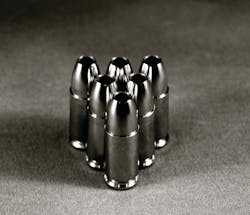“Lead-free” continues to be a buzz word in conversations about ammunition. California was the first state to ban lead in hunting ammo in October, 2013, citing risks to wildlife and hunter health.
While law enforcement agencies continue to struggle with shortages, manufacturers are looking to alternative materials like copper, steel, tungsten, and nickel to replace lead. In some cases lead-free is linked to better performance and cleaner firearms. As these products continue their timely evolution, agencies are looking at things like performance, safety and cost before diving in.
Construction and performance
Chad Thompson is North Carolina Justice Academy’s (NCJA) course coordinator and firearms instructor. When agencies are looking to purchase ammunition for training or patrol, Thompson recommends they seek out what is known as “ballistic equivalent” ammo to circumvent the high cost due to over purchasing by agencies and individuals. This simply means ammo having the same point of aim and impact and having approximately the same amount of felt recoil. He adds, agencies should avoid locally produced “reloads” as these can be dangerous.
“As long as the velocity and pressure are safe, I see no problem with companies using alternative materials for manufacture,” says Thompson. “The only time I would advocate lead-free ammo is if I was restricted to indoor training.
The company Liberty Ammunition out of Bradenton, Fla. offers high performance lead-free ammunition, including very light, very fast handgun rounds consisting of copper with nickel plating. This product purportedly has three times the terminal effect and significant reduction in felt recoil. Liberty Ammunition’s Matt Phillips says for officers the whole the matter really comes down to performance. Less felt recoil means shooters get two, three and four shots on target. “Our rounds dump their energy very quickly so you don’t have the over-penetration issues you’d have from a heavy grain hollow point,” Phillips says.
Unlike heavy grain ammo, this version will take one section of drywall as opposed to three or four. “So in the event you were to miss a bad guy in a house you don’t have to worry about that bullet going four walls over,” says Phillips. “Officers are often shot or harmed by someone they’ve already shot. If they were to hit someone with one of our rounds there’s a very slim chance that person would be able to return fire.”
The company also provides armor piercing rounds for LEOs and Department of Defense—imagine a 9mm that can poke a hole in an engine block at 20 feet from a standard handgun.
Chula Vista, Calif. police currently use lead-free frangible rounds for indoor range training. “We prefer to shoot on steel targets to provide officers immediate visual and auditory feedback for each round, rather than checking a target after a series of rounds,” says Chula Vista Sergeant John Stires. A lead-free facility lessens lead exposure to officers. They use standard full metal jacket rounds at their outdoor range.
Stires says in shooting lead-free, full metal jacket, and duty rounds side by side his officers reported no appreciable difference in point of aim/point of impact between the three types, nor did shooters report a difference in perceived recoil. “I have noticed a higher number of misfires from the lead-free frangible rounds than full metal jacket or duty rounds,” he says.
Some tests indicate leadless ammo may be easier on weapons systems and therefore weapons require less frequent cleaning. The harder metal with nickel plate (tougher than lead) may also prevent deformation in the round.
The ammunition company Corbon looks to copper for improved performance in law enforcement, competition, hunting and self-defense. Their DPX round uses a solid copper bullet with a hollow cavity. Vice President of Public Relations Mike Shovel says this ensures consistent reliable expansion as well as optimal soft tissue penetration.
“Duty ammunition needs to be able to penetrate heavy barriers without over-penetrating soft tissue,” says Shovel. “Training ammunition should simulate duty ammunition as close as possible.”
Down the line
Thompson says, “The most noticeable trend right now is the lack of ability to find ammo. Period. Buy what you can, when you can with today’s climate. Ammo is going to continue to be hard to find for another few years.”
Some of these new offerings may be worth investigating—not just for what they are not, but for how well they hold up in practice. Still, talk about materials and performance is a moot point if agencies still can’t get their hands on the stuff they need for training and duty, or if it is generally unaffordable.
During a recent ammo purchase Sgt. Stires commented rifle ammunition is now readily available; however, he found handgun rounds in 9mm, .40, and .45 are still on about a six-month back-order. Lead-free may be a viable alternative to full metal jacket training rounds…if the price is right.
“The advantages of shooting on steel plates in our own building used to justify the higher cost of lead-free frangible rounds,” says Stires, “but the increasing costs are becoming concerning, and I find myself scheduling training shoots at outdoor venues to allow more training for the same cost.
About the Author

Sara Scullin
Sara Scullin was the Editor of Law Enforcement Technology magazine, a monthly business-to-business publication that covers technology trends and best practices for public safety managers. LET is part of SouthComm Law Enforcement Media, which also publishes Law Enforcement Product News and Officer.com. Sara had covered the law enforcement industry since March 2008.
